Upgrading to a High-Efficiency Wood Stove: Is It Worth It?
- October 27, 2023
- 0 comment
In today’s world, where environmental sustainability and energy conservation are paramount, the answer is a resounding “yes.” As homeowners increasingly seek energy-efficient heating solutions, the high-efficiency wood stove emerges as a front-runner. Not only does it offer a cleaner burn, but the long-term savings and enhanced features make it a compelling choice for those looking to optimize their home heating. Let’s explore the reasons behind its growing popularity and the benefits it brings to the table.
What is a High-Efficiency Wood Stove?
A high-efficiency wood stove is a heating appliance that burns wood fuel more cleanly and efficiently than traditional wood stoves. These stoves are designed with advanced combustion technology that allows them to burn less wood while producing more heat, resulting in fewer emissions and reduced wood consumption.
What Does “Efficiency” Mean for Wood Stoves?
Efficiency tells you how good a stove is at turning fuel into heat for your room instead of losing it up the chimney. For instance, a 75% efficient stove wastes 25% of its heat. When you’re looking at stoves on our site, you’ll see an efficiency number.
Think About These Things Too:
- How much heat do you need for your room size (measured in kW)?
- The kind of wood you burn.
- How good the stove is for the environment.
People often wonder if wood stoves are bad for the planet. Modern stoves that are taken care of and use the right wood don’t release much pollution. They also follow new environmental rules.
To get the most from your stove, use good wood. It should be dry, with moisture below 20%, and best if it’s a type of hardwood that’s been dried in a special oven. Wet wood makes your chimney dirty and the stove works less well, so you’ll buy more wood and clean the chimney more. Also, don’t burn wood that’s been painted or treated; it gives off bad smoke.
What is the Most Efficient Wood Stove?
The King 40 stands out as the world’s most efficient wood stove, boasting an efficiency of 81%. This means you extract maximum heat from the wood, saving on heating expenses. It’s designed for those serious about wood burning, with its unmatched firebox size being the largest and deepest available. Ideal for those in cold areas, bigger homes, or needing extended heating, the King can hold a whopping 80 lbs. of wood in its 4.35 cu. ft. firebox. This translates to a massive 708,275 BTUs of potential wood energy. Depending on where it’s set up and the wood used, the King can either give off intense heat for 12 to 16 hours or stay warm on a low setting for over 40 hours.
How Can You Determine the Best Efficient Wood Stove?
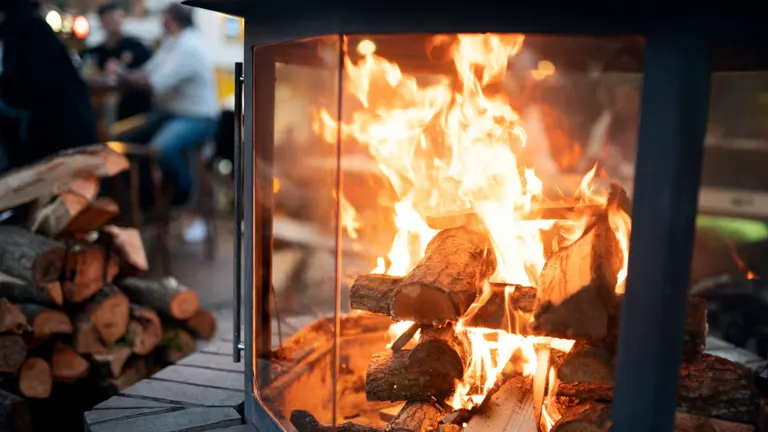
If you’re on the hunt for the most efficient wood-burning stove, Forestry offers some straightforward pointers to guide your decision:
- Check the Heat Output: Before anything else, understand the stove’s heat capability. There’s a useful online tool that estimates the heat output you’ll need based on your room’s size. Remember, this provides a rough idea and isn’t the final word.
- Seek DEFRA-Approved Models: Especially crucial for those residing in smoke-restricted zones. A DEFRA approval ensures the stove meets specific standards for smoke emissions.
- Ecodesign Standards Compliance: From January 2022, all stoves had to meet Ecodesign standards. These standards ensure the stoves are environmentally friendly. Double-check that the stove model you’re eyeing is compliant.
- clearSkies Programme Affiliation: This initiative recognizes solid fuel stoves that excel in both efficiency and low emissions. Opting for a stove under this program assures you’re choosing a top-performing, eco-friendly option.
By keeping these tips in mind, you’ll be better equipped to find a wood stove that’s not only efficient but also eco-friendly and suitable for your specific needs.
Benefits of Upgrading to a High-Efficiency Wood Stove

- One of the undeniable advantages of high-efficiency wood stoves is their ability to minimize environmental harm. By producing fewer pollutants such as particulate matter, carbon monoxide, and volatile organic compounds, these stoves play a crucial role in promoting cleaner indoor and outdoor air.
- Economic benefits are also significant. When using a high-efficiency wood stove, homeowners may find themselves saving up to 30% on wood expenses annually. This translates to a substantial decrease in expenditure over several years.
- No more inconsistent warmth or frequent refilling of the stove! High-efficiency wood stoves are lauded for their consistent and sustained heat output, ensuring that homes remain comfortably warm for longer durations.
- Above all, safety remains paramount. Contemporary high-efficiency wood stoves are equipped with state-of-the-art safety features. These include air wash systems that maintain a clear view through the glass, robust locking mechanisms for added security, and automated shutdown features that activate during overheating or other potential hazards.
Upgrading to a high-efficiency wood stove is not just about better heating; it’s a holistic approach to improved safety, cost savings, and environmental responsibility.
Factors to Consider Before Upgrading

- Initial Cost: Making the switch to a high-efficiency wood stove is an investment. Though they promise greater efficiency over their lifespan, the initial purchase price can be notably higher. It’s essential for homeowners to weigh this upfront cost against the long-term benefits, such as the potential fuel savings and the positive environmental impact.
- Installation Requirements: It’s not always a straightforward swap when transitioning to a high-efficiency stove. Depending on the existing infrastructure, homeowners might need to make adjustments to their current chimney system or even install a new chimney liner. These modifications are crucial to ensure the stove operates safely and at its optimal efficiency. Consulting with a professional installer can provide clarity on what’s needed.
- Maintenance: A cleaner burn doesn’t necessarily mean maintenance-free. High-efficiency wood stoves, despite their advanced combustion technology, still necessitate consistent upkeep. Regular tasks include ash disposal and ensuring the stove’s components are in good working condition. Additionally, an annual inspection and cleaning of the chimney are recommended to prevent creosote buildup and ensure safe operation.
Wood Stove vs. Fireplace: Which Is More Efficient?
Deciding between a fireplace and a wood-burning stove can be a personal choice. Both options use wood, which is often more affordable than other fuel sources. To make an informed decision, it’s essential to weigh their efficiency, safety and looks.
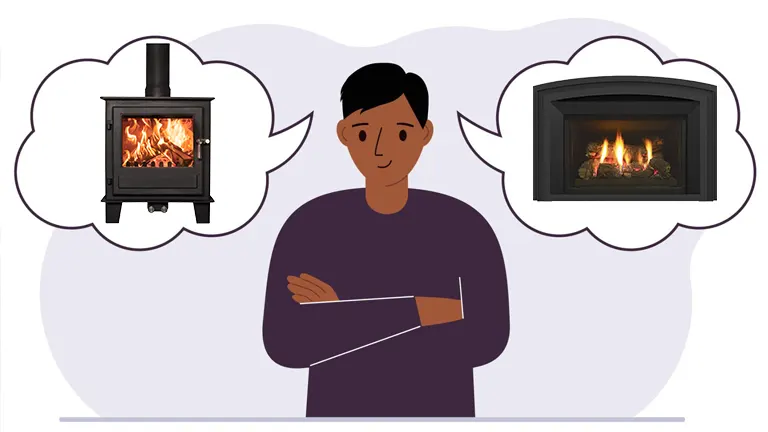
In terms of efficiency, the wood-burning stove is the clear winner. While traditional fireplaces offer a cozy ambiance, they only convert about 25% of the wood’s energy into heat for your home. On the other hand, wood-burning stoves boast an impressive efficiency rate of nearly 80%. This means that stoves give you three times the heat while consuming just a third of the wood that a fireplace would.
So, if your primary concern is getting the most heat for your wood and money, the wood-burning stove is the way to go. However, other factors like safety considerations and aesthetic preferences should also play a role in your final choice.
4 Key Factors To Consider When Buying A Wood Stove
1. BTU Output (Choosing The Right Size)
The BTU/h output is a measure of the heat a wood stove can produce. Wood stove manufacturers typically provide both the maximum BTU heating output and the recommended heating area. For example, the Osborn 2000 wood stove insert has a 75,000 BTU/h output, suitable for heating spaces up to 2,100 sq ft. As a general rule, 60,000 BTU is ideal for a 2,000 sq ft home. However, in colder regions, you might need a higher BTU output. Stoves can be classified as:
- Small: 30,000 BTU to 60,000 BTU.
- Mid-sized: 60,000 BTU to 120,000 BTU.
- Large: 120,000+ BTU.
2. Efficiency (Aim For 70% and Above)
Wood stove efficiency indicates the amount of wood energy converted into heat. For instance, if 14.31 lbs of red oak contains 100,000 BTU, a 50% efficient stove will produce 50,000 BTU of heat, while a 70% efficient stove will produce 70,000 BTU. Although high-efficiency stoves may be pricier upfront, they offer long-term savings by reducing wood consumption. It’s always wise to invest in a high-efficiency model.
3. Emission Rates (Opt For 4.5 g/h Or Lower)
Modern wood stoves have come a long way from the days of “black kitchens” with walls blackened by smoke. Today, EPA-certified models emit less than 4.5 g of smoke per hour, with some even boasting rates below 2.0 g/h. Always choose a stove with an EPA-certified emission rate for a cleaner burn.
4. Burn Time (A Minimum of 5 Hours Is Ideal)
A wood stove’s burn time indicates how often you’ll need to refill it. Longer burn times mean less frequent refilling and the ability to keep the stove burning overnight. Stove engineers achieve this by increasing the wood capacity, enhancing the stove’s performance, or decreasing the BTU/h output. Aim for a stove with a burn time of at least 5 hours for convenience.
Is It Worth the Investment?
Certainly, investing in a high-efficiency wood stove is a wise decision for multiple reasons. Firstly, if you reside in colder regions where wood is a primary heating source, the savings on fuel costs over time can be substantial. These stoves are designed to maximize heat output while using less wood, translating to noticeable cost reductions in the long run. Secondly, the environmental benefits are significant. High-efficiency stoves produce fewer emissions, contributing to cleaner air and a lesser carbon footprint, which is crucial in today’s environmentally-conscious world.
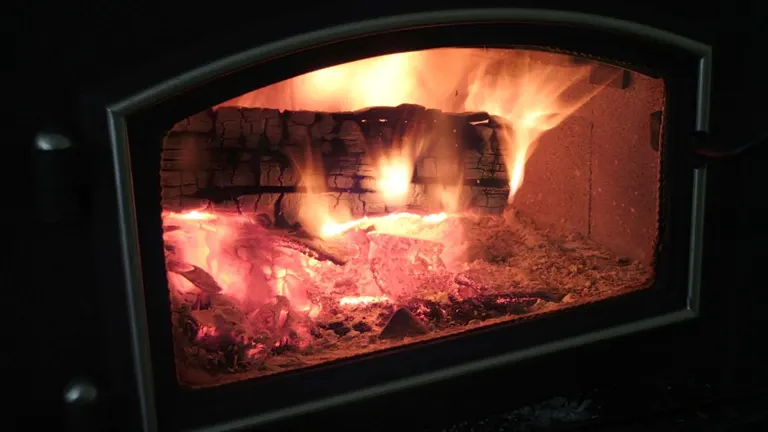
Additionally, the consistent warmth they provide ensures a comfortable living space during chilly months, reducing the frequent need to refuel. And lastly, with the advancements in technology, these modern stoves are built with superior safety features, offering homeowners added peace of mind. In conclusion, when weighing the benefits against the initial investment, a high-efficiency wood stove emerges as a valuable addition to any home.
Jane from Oregon shares, “Since upgrading to a high-efficiency wood stove, my annual wood consumption has decreased significantly. Not only am I saving money, but I also feel good knowing I’m contributing to a cleaner environment.”
Mike from Vermont adds, “The consistent warmth and the advanced safety features of my new stove make winters much more comfortable. I wish I had made the switch sooner!”
Conclusion
Upgrading to a high-efficiency wood stove offers numerous benefits. From reduced emissions and significant fuel savings to advanced safety features, it’s clear that such an upgrade can enhance your home’s heating experience. If you’re considering making the switch, be sure to contact a qualified installer to discuss your options and get a free estimate.
FAQs
- Why are high-efficiency wood stoves often called “secondary burn” or “secondary combustion” stoves?
These stoves are designed to burn the wood gases released during the initial combustion, leading to a second burn phase. This process increases efficiency and reduces emissions. - Can a high-efficiency wood stove help reduce my carbon footprint?
Yes, these stoves produce fewer emissions and use less wood than traditional models, thus reducing the amount of carbon released into the atmosphere. - How does the technology in a high-efficiency wood stove differ from older models?
Modern stoves utilize advanced combustion technology, improved air circulation, and better insulation, which enhances efficiency and reduces harmful emissions. - What’s the difference between a high-efficiency wood stove and a pellet stove?
While both are efficient, wood stoves burn logs, whereas pellet stoves burn compressed wood pellets. Pellet stoves often have automated features and may require electricity, while wood stoves do not. - Do high-efficiency wood stoves require a specific type of chimney or flue system?
Generally, these stoves work best with insulated flue systems to maintain high temperatures and ensure proper drafts. - How often should I clean my high-efficiency wood stove to maintain its performance?
It’s recommended to remove ash regularly, check for creosote buildup monthly, and have a professional chimney cleaning annually. - Are there any tax incentives or rebates available for upgrading to a high-efficiency wood stove?
Some regions offer incentives for eco-friendly heating solutions. It’s best to check with local authorities or environmental agencies for specific programs. - How do I know if my wood is “dry enough” to get the best performance out of a high-efficiency wood stove?
Wood should have a moisture content below 20%. It’s best to season wood for at least 6-12 months before use. Moisture meters can help determine wood’s readiness. - Can I cook on top of a high-efficiency wood stove, or is it just for heating?
Many high-efficiency stoves have flat tops suitable for cooking. However, always check the manufacturer’s guidelines before doing so. - How does the lifespan of a high-efficiency wood stove compare to traditional models?
With proper maintenance, high-efficiency stoves can last just as long, if not longer, than traditional models due to their robust construction and design.
Diving deep into the world of Upgrading to a High-Efficiency Wood Stove: Is It Worth It? has been quite the journey! We genuinely hope you’ve found some useful tidbits along the way. Have thoughts or personal experiences with wood stoves? We’d love to hear them! Drop a comment and let’s get the conversation going. And if a friend or family member is pondering a stove upgrade, why not share this article with them? Thanks for joining us on this exploration, and here’s to many cozy, heartwarming days ahead!

David Murray
Forestry AuthorI'm David Murry, a forestry equipment specialist with a focus on chainsaw operation. With over 13 years of experience, I've honed my skills in operating and maintaining a wide range of machinery, from chainsaws to log splitters. My passion for the outdoors and commitment to sustainable forestry drive my work, which emphasizes safety, efficiency, and staying updated with industry advancements. Additionally, I'm dedicated to sharing my expertise and promoting environmental awareness within the forestry community.

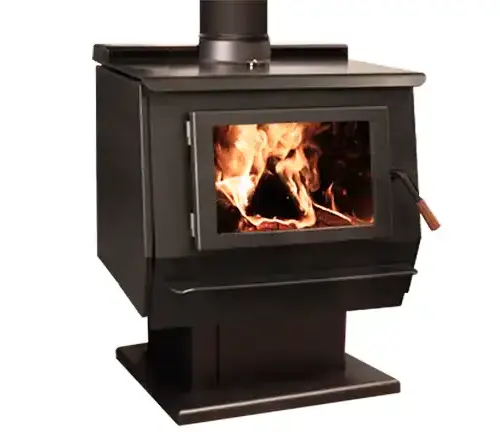





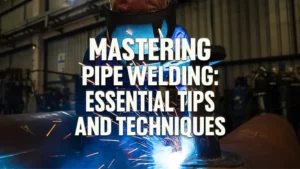





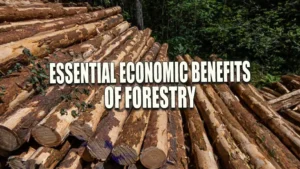
Leave your comment